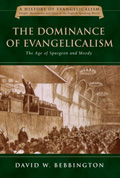
David W. Bebbington
Reviewed by: Richard M. Gamble
The Dominance of Evangelicalism: The Age of Spurgeon and Moody; by David W. Bebbington. Published by InterVarsity Press, 2005. Hardback, 288 pages, list price $23.00. Reviewed by Richard M. Gamble, history professor at Hillsdale College.
Generally focusing their attention within national boundaries, historians of nineteenth-century evangelicalism have too often failed to appreciate the movement's international scope, unity, and coherence, exaggerating differences and missing important similarities. This, at least, is the primary contention of David W. Bebbington's overview of evangelicalism in the English-speaking world in the second half of the nineteenth century. As the middle volume of a projected five-part history of evangelicalism, Bebbington's contribution covers the decades of the movement's growing "dominance" over other forms of Christian faith and practice and over the wider culture, gaining the respectability it coveted, but at the same time becoming almost indistinguishable from the world around it (p. 256). He argues that evangelicals themselves in these years "were often aware of forming a single movement that spanned the world" (p. 263) and that "parallel developments" in the British Empire and North America reveal a "striking" unity (p. 264). This unity held true, he argues, despite diverse denominational allegiances, social and political divisions, geographical separation, and rapid global expansion.
According to Bebbington, four allegiances united nineteenth-century evangelicals: a strict biblicism, the cross of Christ as central to the Atonement, revivalist conversionism, and activism in foreign missions and social reform. To this list could be added a low view of the church. Bebbington indirectly, and perhaps unintentionally, shows that, for the sake of these primary ends, evangelicals (even many of those who called themselves Reformed) downplayed church membership and discipline, ecclesiology, the sacraments, catechism, and the role of ordained clergy. The dominance of evangelicalism as a movement certainly did not mean the dominance of a healthy institutional church. Its unity and success came at a cost.
Bebbington's insistance that "the movement was recognizably one" in the midst of its diversity (p. 52) draws attention to just how broad his definition of evangelicalism is - too broad, perhaps, to be useful or meaningful as a category of description and analysis. His generous evangelicalism includes not only Spurgeon and Moody, but also the liberal preacher Henry Ward Beecher, the Quakers, and the eccentric British journalist William T. Stead, who, while being a good friend of the founder of the Salvation Army, wrote several books about his favorable experiences with necromancy.
Who remains on the outside of this definition? The wisdom of D. G. Hart's recommendation for deconstructing "evangelicalism" as a category of historical analysis (see Deconstructing Evangelicalism: Conservative Protestantism in the Age of Billy Graham) would seem to be amply demonstrated by Bebbington's book. Nevertheless, Bebbington distills a great deal of historical scholarship in his account of evangelicalism's triumph as "the party in possession of the field" (p. 255). He also makes creative use of such sources as obituaries to gauge the beliefs and values of ordinary parishioners - not an easy task. His craftsmanship is meticulous, and his tone is dispassionate. He has produced a concise, readable, and handy reference.
April 14, 2024
How to Read and Understand the Psalms
April 07, 2024
March 31, 2024
My Grandmother Is Praying for Me
March 24, 2024
March 17, 2024
Safeguards: Shielding Our Homes and Equipping Our Kids
March 10, 2024
Ten Words from God: An Exposition of the Ten Commandments
March 03, 2024
Reactivity: How the Gospel Transforms Our Actions and Reactions
© 2024 The Orthodox Presbyterian Church